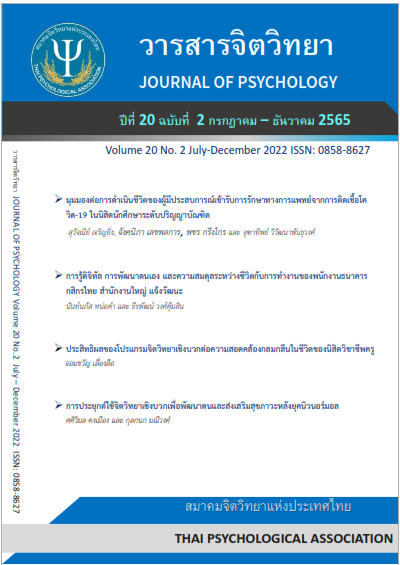ประสิทธิผลของโปรแกรมจิตวิทยาเชิงบวกต่อความสอดคล้องกลมกลืนในชีวิตของนิสิตวิชาชีพครู
คำสำคัญ:
ความสอดคล้องกลมกลืนในชีวิต, นิสิตวิชาชีพครู, กิจกรรมแทรกแซงทางจิตวิทยาเชิงบวกบทคัดย่อ
การวิจัยครั้งนี้มีวัตถุประสงค์ (1) เพื่อเปรียบเทียบความสอดคล้องกลมกลืนในชีวิตของนิสิตวิชาชีพครูก่อนและหลังการทดลอง และ (2) เพื่อศึกษาความพึงพอใจต่อกิจกรรมแทรกแซงทางจิตวิทยาเชิงบวกที่มีต่อความสอดคล้องกลมกลืนในชีวิตของนิสิตวิชาชีพครู กลุ่มตัวอย่างที่ใช้ในการวิจัย เป็นนิสิตวิชาชีพครูชั้นปีที่ 1 สาขาจิตวิทยาและการแนะแนว คณะศึกษาศาสตร์ มหาวิทยาลัยแห่งหนึ่ง จำนวน 25 คน ที่ลงทะเบียนเรียนวิชา ศษ 141 จิตวิทยาสำหรับครู ในปีการศึกษา 2564 เครื่องมือที่ใช้ในการวิจัย คือ แบบวัดความสอดคล้องกลมกลืนในชีวิต มีค่าความเที่ยงทั้งฉบับเท่ากับ 0.89 และโปรแกรมจิตวิทยาเชิงบวก มีค่าดัชนีความสอดคล้องอยู่ระหว่าง 0.60-1.00 สถิติที่ใช้ในการวิเคราะห์ข้อมูล ได้แก่ ค่าเฉลี่ย ส่วนเบี่ยงเบนมาตรฐาน และการวิเคราะห์ความแตกต่างของค่าเฉลี่ยในกลุ่มที่ไม่เป็นอิสระจากกัน ผลการวิจัยพบว่า (1) หลังการทดลองนิสิตวิชาชีพครูมีค่าเฉลี่ยความสอดคล้องกลมกลืนในชีวิตเพิ่มสูงขึ้นอย่างมีนัยสำคัญทางสถิติที่ระดับ .05 และ (2) นิสิตวิชาชีพครูมีความพึงพอใจในการเข้าร่วมกิจกรรมจิตวิทยาเชิงบวกโดยรวม อยู่ในระดับมากที่สุด
References
คณะศึกษาศาสตร์ (2562). มคอ 2 หลักสูตรการศึกษาบัณฑิตปรับปรุงปี 2562. กรุงเทพฯ: มหาวิทยาลัย
ศรีนครินทรวิโรฒ.
นงพงา ลิ้มสมบูรณ์และนิดา ลิ้มสมบูรณ์. (2556). ซาเทียร์ จิตบำบัดและการพัฒนาตนเอง(พิมพ์ครั้งที่ 2).จุฬาลงกรณ์มหาวิทยาลัย.
ประสาท อิศรปรีดา. (2549). สารัตถะจิตวิทยาการศึกษา. พิมพ์ครั้งที่ 5. ขอนแก่น: คลังนานาชาติ.
รัตนา สายพานิชย์. (2557).The Satir Model Family Therapy and Beyond. ห้างหุ้นส่วนจำกัดเฟรม-อัพ ดีไซน์.
สุดารัตน์ ตันติวิวัทน์, (2560). จิตวิทยาเชิงบวก: แนวคิด การพัฒนา และความท้าทายในอนาคต. วารสารพฤติกรรมศาสตร์เพื่อการพัฒนา, 9(1), 1-12.
Bryant, F. (2003). Savoring Beliefs Inventory (SBI): A scale for measuring beliefs about savoring. Journal of mental health, 12(2), 175-196.
Bryant, F.B., Smart, C.M., & King, S.P. (2005). Using the past to enhance the present: Boosting happiness through positive reminiscence. Journal of Happiness Studies, 6(3), 227-260.
Bolier, L. et al. (2013). Positive psychology interventions: a meta-analysis of randomized controlled studies. BMC public health, 13(1), 119.
Duckworth, L.A., Steen, T.A., & Seligman, M. E. (2005). Positive psychology in clinical practice. Annual Review of Clinical Psychology, 1, 629-651.
Folkman, S. & Moskowitz, J.T. (2000). Positive affect and the other side of coping. American psychologist, 55(6), 647.
Fredrickson, B. L. et al. (2008). Open hearts build lives: positive emotions, induced through loving-kindness meditation, build consequential personal resources. Journal of personality and social psychology, 95(5), 1045.
Hodges, S.D., Clark, B. A., & Myers, M. W. (2011). Better living through perspective-taking. In Positive psychology as social change. Springer, 193-218
Kolb, A.Y. & Kolb, D.A. (2009) Experiential Learning Theory: A Dynamic, Holistic Approach to Management Learning, Education and Development. In: Armstrong, S.J. and Fukami, C.V., Eds., The SAGE Handbook of Management Learning, Education and Development, SAGE Publications Ltd., Thousand Oaks, 42-68.
https://doi.org/10.4135/9780857021038.n3
Lee, B. K. (2002). Development of a congruence scale base on the Satir Model. Contemporary Family Therapy, 24(1), 217-237.
Parks, A.C. & Biswas-Diener, R. (2013). Positive interventions: Past, present, and future. Mindfulness, acceptance, and positive psychology: The seven foundations of well-being. New Harbinger Publications: Inc.
Parks, A.C. & Schueller, S. (2014). The Wiley Blackwell handbook of positive psychological interventions. John Wiley & Sons.
Schwartz, B., & Sharpe, K. E. (2006). Practical wisdom: Aristotle meets positive psychology. Journal of Happiness Studies, 7(3), 377-395.
Seligman, M. E. (2012). Flourish: A visionary new understanding of happiness and well-being. Simon & Schuster.
Seligman, M. E., Rashid, T., & Parks, A. C. (2006). Positive psychotherapy. American psychologist, 61(8), 774.
Sin, N.L. & Lyubomirsky, S. (2009). Enhancing well-being and alleviating depressive symptoms with positive psychology interventions: a practice-friendly meta-analysis, 65(5),
-487.
Steger, M.F., Oishi, S., & Kashdan, T.B. (2009). Meaning in life across the life span: Levels and correlates of meaning in life from emerging adulthood to older adulthood. The Journal of Positive Psychology, 4(1), 43-52.
เผยแพร่แล้ว
How to Cite
ฉบับ
บท
License
Copyright (c) 2023 สมาคมจิตวิทยาแห่งประเทศไทย

This work is licensed under a Creative Commons Attribution-NonCommercial-NoDerivatives 4.0 International License.
บทความที่ได้รับการตีพิมพ์เป็นลิขสิทธิ์ของสมาคมจิตวิทยาแห่งประเทศไทย
ข้อความที่ปรากฎในบทความแต่ละเรื่องในวารสารวิชาการเล่มนี้เป็นความคิดเห็นส่วนตัวของผู้เขียนแต่ละท่านไม่เกี่ยวข้องกับสมาคมจิตวิทยาแห่งประเทศไทย แต่อย่างใด ความรับผิดชอบองค์ประกอบทั้งหมดของบทความแต่ละเรื่องเป็นของผู้เขียนแต่ละท่าน หากมีความผิดพลาดใด ๆ ผู้เขียนแต่ละท่านจะรับผิดชอบบทความของตนเองแต่ผู้เดียว





